|
|
|
Sort Order |
|
|
|
Items / Page
|
|
|
|
|
|
|
| Srl | Item |
| 1 |
ID:
124173
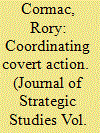

|
|
|
|
|
| Publication |
2013.
|
| Summary/Abstract |
Focusing on British involvement in the 1960s Yemen Civil War, this article examines the centralised mechanisms developed in Whitehall to coordinate covert action interdepartmentally. It therefore sheds new light on London's security and intelligence machine and its input into clandestine operations. Drawing on recently declassified documents and interviews, it uncovers various important but secretive actors, which have been overlooked or misunderstood in the existing literature, and outlines their functions in the most detail yet available. In doing so, it considers how these bodies evolved in relation to competing threat assessments of the local situation and the impact they had on Britain's covert intervention in the theatre. This article assesses the utility of the system and argues that it provided an effective means to ensure that any covert action sanctioned was properly scrutinised so as to reduce risks and best meet national interests.
|
|
|
|
|
|
|
|
|
|
|
|
|
|
|
|
| 2 |
ID:
188388
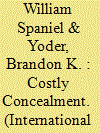

|
|
|
|
|
| Summary/Abstract |
This article presents a formal model that shows how states can credibly reassure each other simply by maintaining a cooperative outward narrative. The reassurance literature to date has focused largely on costly signaling, whereby benign states must distinguish themselves by taking specific actions that hostile types would not. The mere lack of overtly expressed hostility without costly signals has been considered “cheap talk,” on the assumption that this behavior is costless for hostile states and thus uninformative. In contrast, this paper argues that maintaining a cooperative façade while secretly formulating and executing exploitative policies carries inherent trade-offs, and thus constitutes a credible reassurance signal. Foreign policy planning and implementation requires communication among various individuals, groups, and organizations, which has some probability of being observed and punished by outside actors. Yet efforts to conceal the policymaking process and reduce this probability are costly—they require investments in internal monitoring and restrictions on internal communication that can substantially degrade policy outcomes. Thus, to the extent that a state's foreign policymaking process is transparent—that is, that concealing internal communications is difficult—the absence of positive signals of hostility is a credible signal of its benign intentions. The argument is illustrated with a case study of German reassurance signals during the July Crisis preceding World War I.
|
|
|
|
|
|
|
|
|
|
|
|
|
|
|
|
| 3 |
ID:
016387
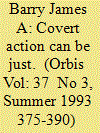

|
|
|
|
|
| Publication |
Summer 1993.
|
| Description |
375-390
|
|
|
|
|
|
|
|
|
|
|
|
|
|
|
|
| 4 |
ID:
183164
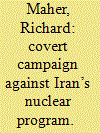

|
|
|
|
|
| Summary/Abstract |
This paper examines the covert campaign against Iran’s nuclear program and the implications it holds for both the theory and the practice of counterproliferation. The paper evaluates the degree to which covert action succeeded in producing meaningful delays and disruptions to Iran’s nuclear progress, in enhancing U.S. diplomatic leverage, and in helping to compel Iranian leaders to accept limits and restrictions on their country’s nuclear activities. More broadly, the paper analyzes the merits and viability of covert counterproliferation strategies, including how to define and measure the effectiveness of covert counterproliferation activity and how and under what conditions covert counterproliferation can be effective.
|
|
|
|
|
|
|
|
|
|
|
|
|
|
|
|
| 5 |
ID:
153939
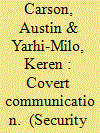

|
|
|
|
|
| Summary/Abstract |
Can states credibly communicate their intentions through covert policy tools, despite the absence of credibility-enhancing publicity? Most extant research suggests covert action and secrecy in general are uniquely uninformative and often used as an alternative to signaling. Yet episodes such as Richard Nixon's secret bombing of Cambodia suggest that leaders have used covert action to convey intentions and coerce adversaries. This article builds a theoretical framework for understanding signaling in the covert sphere, developing reasons why states find covert communication both intelligible (that is, the basic intended message is understandable) and credible (that is, the message is believable). We argue that two target audiences—local allies and strategic adversaries—tend to observe covert action and that the costs and risks incurred by initiating and expanding covert action credibly convey resolve. We assess our arguments empirically through careful process tracing of a set of nested covert interventions by Soviet and American leaders in conflicts in Angola and Afghanistan. Drawing on a trove of recently declassified material, we assess intentions and inferences related to covert signaling. We find that both strategic adversaries and local partners observed and drew inferences about resolve. Covert lethal aid programs thereby served as a credible indicator of resolve through three mechanisms we identify in the paper: sunk costs, counter-escalation risks, and domestic political risks. These findings have important implications for the study of coercive bargaining, secrecy, and reputation. They also shed light on an important policy tool contemporary policymakers will likely use, suggesting the kinds of effects covert action has and elucidating the basic interpretive framework needed to communicate messages with new methods like covert cyber attacks.
|
|
|
|
|
|
|
|
|
|
|
|
|
|
|
|
| 6 |
ID:
188251
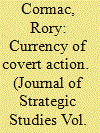

|
|
|
|
|
| Summary/Abstract |
At the start of the 1960s, the UK embarked on a programme of covert action in Latin America. This appears puzzling: the UK was overstretched; Latin America fell outside its area of strategic interest; and UK covert action was dwarfed by that of the US. After revealing this activity for the first time, this article argues that the UK turned to covert action for reasons beyond orthodox explanations of reducing threats in a plausibly deniable manner. Instead, policymakers recognised the currency of covert action in the Anglo-American relationship and in generating trade with emerging economies in Latin America.
|
|
|
|
|
|
|
|
|
|
|
|
|
|
|
|
| 7 |
ID:
171241
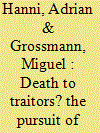

|
|
|
|
|
| Summary/Abstract |
This article argues that Russia’s use of lethal violence against intelligence defectors has to be understood as a public spectacle in which Russian leaders and intelligence officials never intended to hide their role. This “theatrical murder” functions primarily as a political signaling tool for a reasserting Russia to communicate to distinct domestic and foreign audiences. We historicize the phenomenon by outlining and explaining the KGB’s approach towards defectors during the Cold War and show that “theatrical murder” is a unique feature of Russia under Putin’s rule. The empirical findings are used to significantly advance theorizing on signaling through covert action.
|
|
|
|
|
|
|
|
|
|
|
|
|
|
|
|
| 8 |
ID:
153644
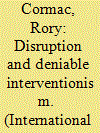

|
|
|
|
|
| Summary/Abstract |
The United Kingdom has long engaged in covert action. It continues to do so today. Owing to the secrecy involved, however, such activity has consistently been excluded from debates about Britain’s global role, foreign and security policy and military planning: an important lacuna given the controversy, risk, appeal and frequency of covert action. Examining when, how and why covert action is used, this article argues that contemporary covert action has emerged from, and is shaped by, a specific context. First, a gap exists between Britain’s perceived global responsibilities and its actual capabilities; policy elites see covert action as able to resolve, or at least conceal, this. Second, intelligence agencies can shape events proactively, especially at the tactical level, while flexible preventative operations are deemed well suited to the range of fluid threats currently faced. Third, existing Whitehall machinery makes covert action viable. However, current covert action is smaller scale and less provocative today than in the early Cold War; it revolves around ‘disruption’ operations. Despite being absent from the accompanying debates, this role was recognised in the 2015 Strategic Defence and Security Review, which placed intelligence actors at the heart of British thinking.
|
|
|
|
|
|
|
|
|
|
|
|
|
|
|
|
| 9 |
ID:
192519
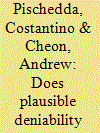

|
|
|
|
|
| Summary/Abstract |
States conduct unclaimed coercive acts, imposing costs on adversaries to signal resolve but denying (or not claiming) responsibility. Some scholars posit that unclaimed acts have considerable potential to coerce targets, while containing escalation risks. Others suggest that unclaimed coercive efforts tend to fail and trigger escalation. We assess these competing perspectives about the effects of unclaimed attacks with a vignette experiment exposing US-based respondents to a scenario where, after Russia warns of unpredictable consequences if NATO continues providing weapons to Ukraine, an explosion occurs at a NATO base in Poland used to funnel weapons to Ukraine. Intelligence agencies and independent analysts identify Russia as the likely culprit, while not ruling out the possibility of an accident. We randomize whether Russia claimed or denied responsibility for the explosion and find that unclaimed acts have lower coercive leverage than claimed ones, but the two do not significantly differ in escalation risk.
|
|
|
|
|
|
|
|
|
|
|
|
|
|
|
|
| 10 |
ID:
192292
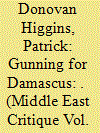

|
|
|
|
|
| Summary/Abstract |
Commentators across Anglophone media and academic institutions frequently have minimized the role of US-led imperialism in Syria. This trivialization has been made possible by the covert nature of the war’s initial phases. Therefore, this article aims to piece together some of the most conspicuous aspects of the empirical record of the war. It begins with a historical overview of major US attacks against Syria, as well as prevailing attitudes about Syria within the US National Security Establishment (NSE), between the end of the WWII and 2011. The second part aggregates and reviews the existing empirical record on the current war, beginning with the Bush Administration’s preparations for operations subsequently launched under the Obama Administration in 2011, then continuing to be waged under the following administrations. The conclusion offers some theoretical remarks on the wider regional context of the US’s aims in Syria, highlighting their connections to various developments elsewhere in the region, ranging from similar wars nearby, to recent political losses suffered by the Palestinian national movement.
|
|
|
|
|
|
|
|
|
|
|
|
|
|
|
|
| 11 |
ID:
159747


|
|
|
|
|
| Summary/Abstract |
States wishing to use force in the modern era frequently face strong incentives to exploit secrecy. Successful covert operations can reduce the likelihood of unwanted escalation with powerful rivals and help leaders conceal unpopular actions from domestic and foreign audiences alike. The many benefits of secrecy, however, can only be realized if covert operations remain covert. We argue that access to information and communications technologies (ICTs) is a critical factor that increases the chances that a covert mission will be exposed. As a result, leaders are much less likely to reach for the quiet option when a potential target has dense ICT networks. We illustrate our mechanism through US national security archival vignettes. We test our argument using a dataset of declassified US military and electoral interventions intended to subvert incumbent regimes throughout the Cold War. The core finding, that leaders are less likely to pursue covert action relative to alternative options when the chances of exposure are high, holds across five distinct measures of ICT networks as well as different model specifications and placebo tests. Our findings suggest that Cold War-style covert operations may well be a thing of the past in an age where communication and media technologies have proliferated to the far corners of the globe. We advance debates on communications technologies, covert action, and political violence.
|
|
|
|
|
|
|
|
|
|
|
|
|
|
|
|
| 12 |
ID:
146317
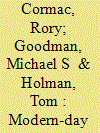

|
|
|
|
|
| Summary/Abstract |
Covert action can be an important weapon in a state’s arsenal. It is, however, inherently controversial and risky. Rory Cormac, Michael S Goodman and Tom Holman argue that when considering covert action, Whitehall should look to lessons from the recent past. The UK has long used covert action, and how best to manage and co-ordinate such sensitive activity was for many decades a key preoccupation of its policy-makers and politicians. Given the secrecy involved, these lessons, and the machinery created, have been lost to history. Yet with covert action seemingly now back on the agenda, previous experience and hard-learnt lessons have assumed renewed importance.
|
|
|
|
|
|
|
|
|
|
|
|
|
|
|
|
| 13 |
ID:
181631
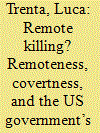

|
|
|
|
|
| Summary/Abstract |
The recent assassinations of General Soleimani and Mohsen Fakhrizadeh have renewed debates surrounding governments’ use of assassination. Some commentators have interpreted these episodes as an escalation in practices of “remote warfare.” Recently, the literature on remote warfare has expanded to include multiple activities at – and below – the threshold of war. From its original focus on geographical distance, “remoteness” now encompasses the “political” distance of deployments of force. In this understanding, “remoteness” has blurred the line separating the methods used to deploy force and the ways – overt or covert – in which they are deployed. Having highlighted the role of covertness, this article establishes that assassination should be included in the “remote warfare” canon. A study of the US government’s involvement in assassination permits us to elucidate the interplay between remoteness and covertness. The article shows that a deeper engagement with the assassination as a tool of US foreign policy provides two main advantages. First, it permits us to better historicise the “opacity” and “political distance” of practices associated with “remote warfare.” Second, it helps unveil the origins of the legal, political, and technological infrastructures that currently sustain much of the US government’s global “remote wars.”
|
|
|
|
|
|
|
|
|
|
|
|
|
|
|
|
| 14 |
ID:
186096


|
|
|
|
|
| Summary/Abstract |
Despite its prominence as a tool of statecraft, covert action’s defining characteristic – plausible deniability – remains a slippery concept. This article investigates the logics underlying the two main variants. The first ideal-type, the state model, captures efforts by states to disclaim sponsorship of covert operations. The drivers of covert action are primarily international, the sources of exposure are many, and its relationship with democratic norms is harmonious. The second ideal-type, the executive model, describes efforts to shield chief executives from blame. The drivers of covert action are domestic, the sources of exposure are limited, and its relationship with democracy is conflictual.
|
|
|
|
|
|
|
|
|
|
|
|
|
|
|
|
| 15 |
ID:
142615
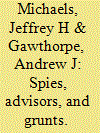

|
|
|
|
|
| Summary/Abstract |
Vietnam was a complex conflict, which historians and political scientists have struggled to understand. Some of the bitterest disputes in the historiography revolve around the US approach to counterinsurgency in Vietnam. Many different facets of the war have received the attention of filmmakers, and an examination of their work suggests new ways of thinking about the conflict. This article considers film portrayals of three phases of the Vietnam War – firstly, the early period of ‘political action’, then the advisory period, and finally the Americanization of the war after 1965. It suggests that by examining the experiences of participants in each of these phases, Vietnam War cinema helps to illustrate the problems that faced various American approaches to counterinsurgency in the conflict. Combined with the importance of films in determining popular perceptions of both historical conflicts and counterinsurgency in general, it suggests that they are worthy subjects of study and critique.
|
|
|
|
|
|
|
|
|
|
|
|
|
|
|
|
| 16 |
ID:
188255
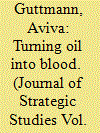

|
|
|
|
|
| Summary/Abstract |
How can multilateral liaison be used as a tool to counter state-sponsored terrorism? This article analyses cooperation among 18 Western European intelligence agencies to counter Libyan-Palestinian terrorism in Europe in the early 1970s. Two arguments are presented. Concerning Western perceptions of Palestinian-Libyan operations, the article argues that the intelligence reports overestimated Libyan influence over Palestinian actions. Concerning intelligence cooperation, the article argues that intelligence was shared to collectively understand the threat posed by Libya but also to send implicit political messages. The article is based on unprecedented access to records from a multilateral liaison called the Club de Berne.
|
|
|
|
|
|
|
|
|
|
|
|
|
|
|
|
| 17 |
ID:
140992
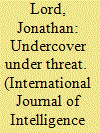

|
|
|
|
|
| Summary/Abstract |
Almost every human activity now creates, or is in some way informed or affected by, digital information. The methods by which commerce, communication, socialization, and learning are conducted have all been digitized. The world's second-oldest profession—espionage—is no exception. Digital information's ubiquity has had a profound and indelible impact on intelligence collection methods. The last century has witnessed both the emergence of intelligence collection disciplines rooted in technology and the impact of technological change upon the original discipline of human intelligence. A visit to Washington, DC's National Spy Museum will reveal the hundreds of devices designed and used to both support and thwart U.S. intelligence operations. While, previously, technological innovation had an incremental impact on intelligence, today's emerging digital environment has the potential to wholly transform the foundation upon which intelligence rests: secrecy.
|
|
|
|
|
|
|
|
|
|
|
|
|
|
|
|
| 18 |
ID:
059684
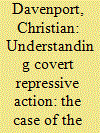

|
|
|
| 19 |
ID:
183704
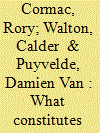

|
|
|
|
|
| Summary/Abstract |
Covert action has long been a controversial tool of international relations. However, there is remarkably little public understanding about whether it works and, more fundamentally, about what constitutes success in this shadowy arena of state activity. This article distills competing criteria of success and examines how covert actions become perceived as successes. We develop a conceptual model of covert action success as a social construct and illustrate it through the case of ‘the golden age of CIA operations’. The socially constructed nature of success has important implications not just for evaluating covert actions but also for using, and defending against, them.
|
|
|
|
|
|
|
|
|
|
|
|
|
|
|
|
|
|
|
|
|